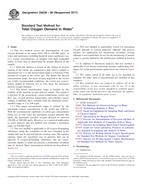Potrebujeme váš súhlas na využitie jednotlivých dát, aby sa vám okrem iného mohli ukazovať informácie týkajúce sa vašich záujmov. Súhlas udelíte kliknutím na tlačidlo „OK“.
ASTM D6238-98(2011)
Standard Test Method for Total Oxygen Demand in Water
Automaticky preložený názov:
Štandardná skúšobná metóda pre Total spotreba kyslíka vo vode
NORMA vydaná dňa 1.5.2011
Informácie o norme:
Označenie normy: ASTM D6238-98(2011)
Poznámka: NEPLATNÁ
Dátum vydania normy: 1.5.2011
Kód tovaru: NS-34340
Počet strán: 7
Približná hmotnosť: 21 g (0.05 libier)
Krajina: Americká technická norma
Kategória: Technické normy ASTM
Kategórie - podobné normy:
Anotácia textu normy ASTM D6238-98(2011) :
Keywords:
BOD, COD, laboratory analyzer, online monitor, oxygen demand, total oxygen demand, COD (chemical oxygen demand), Online monitoring (in water analysis), Oxygen demand (in water), Total oxygen demand (TOD), ICS Number Code 13.060.50 (Examination of water for chemical substances)
Doplňujúce informácie
| Significance and Use | ||||||||||||||||||
|
The measurement of oxygen demand parameters is critical to the control of process wastewaters. Biochemical oxygen demand (BOD) and chemical oxygen demand (COD) analyzers have long time cycles and in the case of COD analyzers use corrosive reagents with the inherent problem of disposal. Total oxygen demand analysis is faster, approximately 3 min, and uses no liquid reagents in its analysis. TOD can be correlated to both COD and BOD, providing effective on-line control. TOD offers several features which make it a more attractive measurement than carbon monitoring using Total Carbon (TC) or Total Organic Carbon (TOC) analyzers. TOD is unaffected by the presence of inorganic carbon. TOD analysis will also indicate noncarbonaceous materials that consume or contribute oxygen. For example, the oxygen demand of ammonia, sulfite and sulfides will be reflected in the TOD measurement. Also, since the actual measurement is oxygen consumption, TOD reflects the oxidation state of the chemical compound (that is, urea and formic acid have the same number of carbon atoms, yet urea has five times the oxygen demand of formic acid). |
||||||||||||||||||
| 1. Scope | ||||||||||||||||||
|
1.1 This test method covers the determination of total oxygen demand in the range from 100 to 100 000 mg/L, in water and wastewater including brackish waters and brines (see 6.5). Larger concentrations, or samples with high suspended solids, or both, may be determined by suitable dilution of the sample. 1.1.1 Since the analysis is based on the change in oxygen reading of the carrier gas compared to that when a sample is introduced (see 4.1), the measurement range is a function of the amount of oxygen in the carrier gas. The higher the desired concentration range, the more oxygen required in the carrier gas. Under recommended conditions, the carrier gas concentration should be between two to four times the maximum desired oxygen demand. 1.1.2 The lower measurement range is limited by the stability of the baseline oxygen detector output. This signal is a function of the permeation system temperature, carrier gas flow rate, oxygen detector temperature, and reference sensor voltage. Combined, these variables limit the minimum recommended range to 2 to 100 mg/L. 1.1.3 The upper measurement range is limited by the maximum oxygen concentration in the carrier gas (100 %). With the recommended conditions of carrier gas concentration being two to four times the maximum oxygen demand, this limits the maximum possible oxygen demand to between 250 000 to 500 000 mg/L. However, as a practical application to water analysis, this test method will consider a maximum range of 100 000 mg/L. 1.2 This test method is applicable to all oxygen-demanding substances under the conditions of the test contained in the sample that can be injected into the reaction zone. The injector opening limits the maximum size of particles that can be injected. If oxygen-demanding substances that are water-insoluble liquids or solids are present, a preliminary treatment may be desired. These pretreatment methods are described in Annex A2. 1.3 This test method is particularly useful for measuring oxygen demand in certain industrial effluents and process streams. Its application for monitoring secondary sewage effluents is not established. Its use for the monitoring of natural waters is greatly limited by the interferences defined in Section 6. 1.4 In addition to laboratory analysis, this test method is applicable to on-stream monitoring. Sample conditioning techniques for solids pretreatment applications are noted in Annex A2. 1.5 The values stated in SI units are to be regarded as standard. No other units of measurement are included in this standard. 1.6 This standard does not purport to address all of the safety concerns, if any, associated with its use. It is the responsibility of the user of this standard to establish appropriate safety and health practices and determine the applicability of regulatory limitations prior to use. |
||||||||||||||||||
| 2. Referenced Documents | ||||||||||||||||||
|
Odporúčame:
Aktualizácia technických noriem
Chcete mať istotu, že používate len platné technické normy?
Ponúkame Vám riešenie, ktoré Vám zaistí mesačný prehľad o aktuálnosti noriem, ktoré používate.
Chcete vedieť viac informácií ? Pozrite sa na túto stránku.




 Cookies
Cookies
